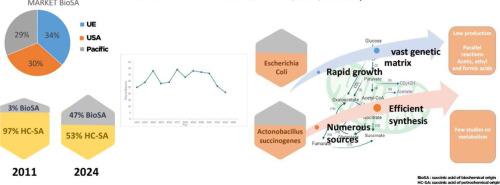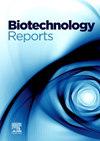生物琥珀酸的勘探技术及经济潜力综述
Q1 Immunology and Microbiology
引用次数: 0
摘要
琥珀酸(SA)是一种有机酸,在食品、制药和化学工业中有着广泛的合成应用。目前通过石化途径生产,利用微生物从生物质废物中生产它提供了一种可再生和可持续的替代方案。本研究对生物技术途径(BioSA)生产琥珀酸的主要技术及其市场潜力进行了评价,以期实现商业化生产。研究强调了BioSA的竞争优势和合成高价值产品的显著能力,如1,4-丁二醇和聚丁二酸丁二醇(PBS),为化石来源的马来酸酐提供了可行的替代品。在产生biosa的微生物中,大肠杆菌和丁二酸放线菌是最有前途的,在低pH厌氧条件下,其滴度分别为1.10和1.23 mg -1,产率为127.1和83.7 gL-1。预计到2032年,该市场将以每年6.7%的速度增长。本文章由计算机程序翻译,如有差异,请以英文原文为准。

Prospecting technology and economic potential to produce bio-succinic acid: a review
Succinic acid (SA) is an organic acid and a key building block with various synthetic applications in the food, pharmaceutical, and chemical industries. Currently produced through petrochemical routes, the use of microorganisms to produce it from biomass waste offers a renewable and sustainable alternative. This study evaluates the main technologies for producing succinic acid via biotechnological routes (BioSA) and its market potential, aiming for commercial production. Research highlights BioSA’s competitive edge and significant capacity to synthesize high-value products, such as 1,4-butanediol and polybutylene succinate (PBS), offering a viable alternative to fossil-derived maleic anhydride. Among BioSA-producing microorganisms, Escherichia coli and Actinobacillus succinogenes are the most promising, achieving titers of 1.10 and 1.23 gg-1, respectively, and yields of 127.1 and 83.7 gL-1 under anaerobic conditions at low pH, with genetic modifications to maximize productivity. The market is expected to grow at an annual rate of up to 6.7 % through 2032.
求助全文
通过发布文献求助,成功后即可免费获取论文全文。
去求助
来源期刊

Biotechnology Reports
Immunology and Microbiology-Applied Microbiology and Biotechnology
CiteScore
15.80
自引率
0.00%
发文量
79
审稿时长
55 days
期刊介绍:
Biotechnology Reports covers all aspects of Biotechnology particularly those reports that are useful and informative and that will be of value to other researchers in related fields. Biotechnology Reports loves ground breaking science, but will also accept good science that can be of use to the biotechnology community. The journal maintains a high quality peer review where submissions are considered on the basis of scientific validity and technical quality. Acceptable paper types are research articles (short or full communications), methods, mini-reviews, and commentaries in the following areas: Healthcare and pharmaceutical biotechnology Agricultural and food biotechnology Environmental biotechnology Molecular biology, cell and tissue engineering and synthetic biology Industrial biotechnology, biofuels and bioenergy Nanobiotechnology Bioinformatics & systems biology New processes and products in biotechnology, bioprocess engineering.
 求助内容:
求助内容: 应助结果提醒方式:
应助结果提醒方式:


